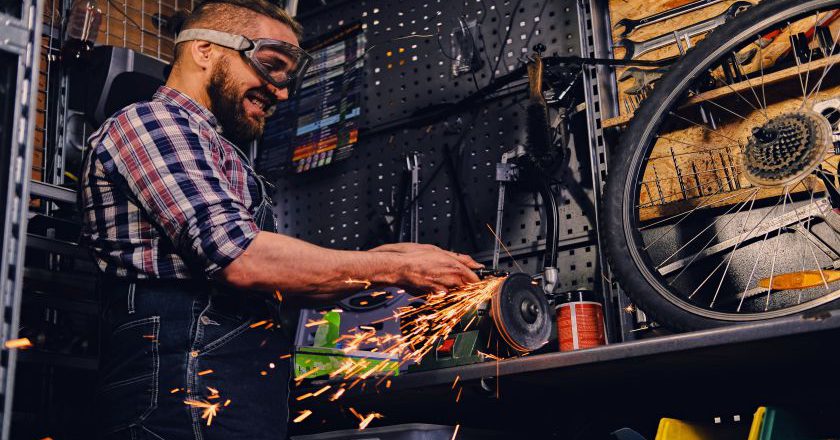While the machine marks left on metal parts fabricated using CNC machining are visually pleasing to some, additional post-processing is desired or perhaps much required. There is a spread of finishes that one can use to feature functionality or aesthetic appeal to parts, and also the glossary below will facilitate your decision on which of them could even be a better choice for your necessary application.
In this article of Dainsta, we’ll learn about:
- Anodizing
- Heat Treating
- Laser Etching
- Media Blasting
- Plating
- Polishing
- Powder Coating
- Sanding
Anodizing

Anodizing is a process accustomed to increase the thickness of the natural oxide layer on the surface of metal parts, primarily those made up of aluminium. This process serves both functional and cosmetic purposes—anodizing a component won’t only form a layer on the part’s surface to protect from scratching and corrosion, but parts are also left with a matte finish, and expansion of colour dyes are going to be added during the tactic.
There are two main kinds of aluminium anodizing:
Type II adds corrosion protection, is just about 0.001” thick (meaning part dimensionality is virtually unchanged), and incorporates a large range of colour dye options.
Type III, known as hard anodizing, gives a more solid and more protective coating but is more restrained in colour, often clear or black only.
Heat Treating

There are several sorts of heat treating, but all relate to the heating of metal in several ways and for various lengths of some time to vary its properties.
The most common styles of heat treatment done on finished parts (most often steel) result in an increased hardness of the part. this might be desired for a decent kind of functional reasons, like long-term dimensional consistency or wear resistance.
An adverse effect of heat processing is that it will leave the part exterior with a dull grey surface finish due to the heat intensity.
Laser Etching

Laser etching or engraving works by utilizing—you guessed it—lasers, which operate at high frequencies to mark a component with text, symbols, a logo, or other patterns. Most metals, and lots of other materials, could also be readily etching by tuning the laser appropriately.
A typical use of this method is to mark parts with serial numbers. Laser etching also operates on anodized parts and may shift the anodized layer to expose the bare metal below, which is great for top contrast logos or patterns.
Media Blasting

This is a cosmetic finishing technique that gives metal parts a matte appearance.
The “media” in media blasting can sit down with several types of small granular materials, like glass beads or corundum (sand). the material is fired at parts at a high velocity to use a textured surface finish. In prototyping, this will be finished a handheld spray nozzle, that the finish isn’t as while more automated blasting done during production runs.
Plating

Plating may well be a metal finish that involves coating a metal spare an awfully thin layer of another metal or metal alloy, to safeguard from corrosion and oxidation of the underside part, or to vary its cosmetic appearance. Tin, Nickel, Zinc (galvanizing), and Chrome are all common plating metals, while copper and steel are two base metals that will like plating.
Polishing

The subsequent finishing step after sanding in terms of exterior refinement is Polishing. Polishing normally uses a wheel or soft applicator and polish aggregate to bring a part’s surface an extra-fine finish. Practical applications of this process include optical clarity or reflectivity of parts, and smoothing machined grooves or other features for sealing designs.
Many metals are polished, though with intricate geometries it’s going to be tough to attain every surface, and harder metals like 304 and 316 stainless-steel are often time-consuming and expensive to understand a high-grade finish.
As an alternate at hand polishing and sanding, parts are often tumbled—where they’re placed during an outsized rotating drum, with or without an abrasive media. This drum rotates the parts for long periods to permit them a refined surface finish. While selective finishing can’t be performed this fashion, and high levels of polish aren’t as readily achievable, it has always more economical because parts are also tumbled in large batches and without operator oversight.
Powder Coating

Powder coating of parts is completed by applying a dry polymeric powder to a metal part using differences in voltage.
Parts to be coated are electrically grounded; then, the powder is sprayed from an electrostatic gun or other sources that induce it with an electrical phenomenon, causing it to remain to the part. Finally, the coated part is heat-cured and voilá! A protective coating that comes in many colours.
One consideration: it’ll add thickness to your part, so dimensionality should be taken into consideration during part design, if possible.
Sanding

Sanding is one of the most basic metal finishing processes but still are often quite varied for superficial finishing. Sanding a metal part quickly with heavy or medium grit sandpaper can quickly remove tool marks, while progressively working a component with finer and finer grits will end in a smooth, uniform, and even lustrous finish.
Just remember, the harder the metal, the longer it takes for sanding, so stuff like steel can get expensive if you’re not the one setting up the right place for it.
We at Dainsta believe experimentation is the name of the game—don’t be afraid to try to to a finish you’re unfamiliar if your design requirements allow or entail it. You may find artistic or functional benefits you never contemplated before. If you are interested to read more on similar manufacturing topics, you can check out our other fascinating blogs here.
